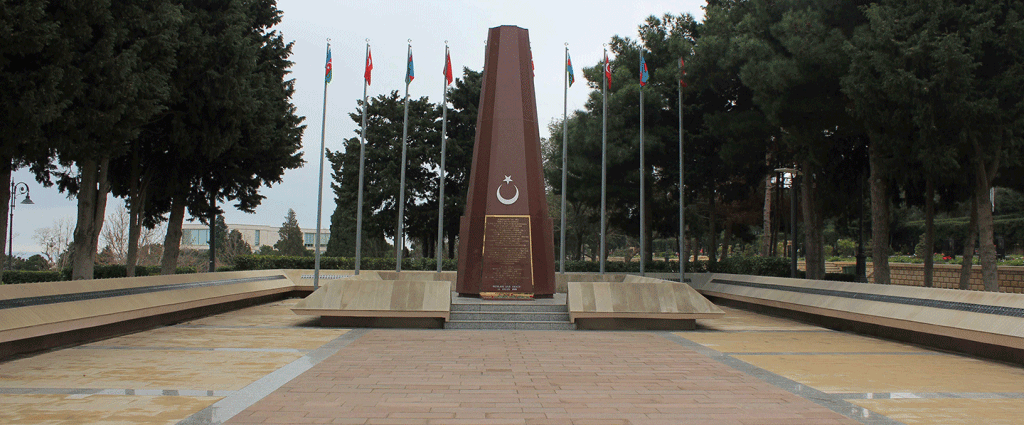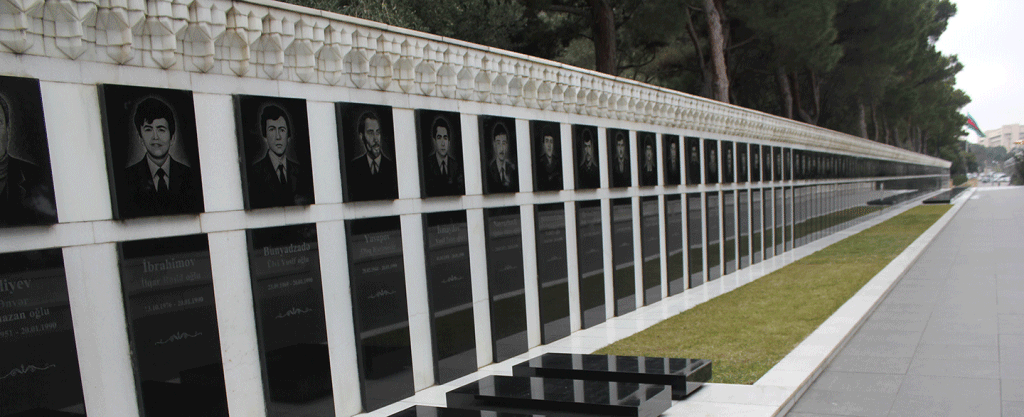
MODERN HISTORY
Russian occupation
After the Safavids
After the Safavids reign ended, Azerbaijan was ruled by the Turkic dynasties of Afshar and Zand. Finally, it was ruled briefly by the Qajars, until they were forced to cede to Russia in the 19th century. Independent, self-ruling ‘khanates’ had also emerged during 19th century. The khanates exercised control over their affairs via international trade routes between Central Asia and the West.
From the late 18th century and on, Imperial Russia changed to a more aggressive geo-political stance. This was directed towards its two neighbours (and rivals) to the south; namely Iran and Turkey. Russia would now actively contest and battle over possession of the Caucasus region. For most of its part, in the hands of Iran. The successful Russian campaigns in the later stages of the Russo-Persian War (1804–13) were concluded with the Treaty of Gulistan. In this treaty the Iranian claims to some of the Khanates of the Caucasus were dismissed by Russia. Reasoning was on the grounds that they had been independent long before their Russian occupation.
Key Treaties and Russian Wars
According to Gulistan and Turkmenchay Treaties of 1813 and 1828 ,the Russo-Persian War (1804-1813) and The Russo-Persian War (1826-1828), helped force the cession of the Georgia, Dagestan and Armenia areas.
The Gulistan Treaty was signed in 1812, as Russia tailed war with Turkey and went on the offensive against Persia. During this territorial expansion, the British assisted the defending Persian territories. However boarders were greatly altered. Azerbaijan was divided as Russia took control of the northern area of Azerbaijan. Erstwhile Southern Azerbaijan remained under the control of the Qajar state (Persia). Qajar signed the Treaty and confirmed the changes that had taken place. Local khanates were either abolished (like in Baku or Ganja) or accepted Russian patronage.
The Treaty of Turkmenchay was signed in the second Russo-Persian war, in 1828; defining the current borders of Azerbaijan and Iran (Persia). In the newly Russian-controlled territories, two provinces were established that later constituted the bulk of the modern Republic: Ganja province in the west, and Shamakha province in the east. In accordance with the Turkmenchay Treaty a large number of Armenians from Turkey and Persia were resettled at the territories of the Irevan, Nakhchivan and Karabakh khanates. As a result of this, the Azerbaijani ethnic group is nowadays parted between two nations: Iran and Azerbaijan. Furthermore, the numbers of ethnic Azerbaijanis in Iran far outnumber those in neighbouring Azerbaijan.
Collapse of Russian Empire and the ADR
After the collapse of the Russian Empire during World War I, Azerbaijan, together with Armenia and Georgia became part of the short-lived Transcaucasian Democratic Federative Republic. When this republic dissolved in May 1918, Azerbaijan declared independence as the Azerbaijan Democratic Republic (ADR). The ADR was the first modern parliamentary republic in the Muslim world.
A government system was developed in which a Parliament elected on the basis of universal, free, and proportionate representation and was the vessel of state authority; the Council of Ministers was held responsible before it. Among the important accomplishments of the Parliament was the extension of suffrage to women, making Azerbaijan the first Muslim nation to grant women equal political rights with men. Another was the establishment of Baku State University, which was the first modern-type university founded in Muslim East. Most of the population led secular lives and were historically tolerant of different ideas and beliefs.
March Days Massacres
Starting on March 31, 1918 a series of atrocities were carried out by Armenians, genocidal acts against Azerbaijanis. The bloody events committed by Armenian-Bolshevik forces in Baku gained a mass scale on March 31 and April 1-2 as armed Armenian groups killed civilians mercilessly.
30 000 people in Baku and in surrounding villages were murdered on the basis of nationality. Mosques and schools were burned and Armenians fired at, and destroyed, many historic buildings. Hundreds of villages were completely destroyed and all property of peaceful Muslim population was looted.
In the Guba province innumerable human bones are visual evidences of the Armenian vandalism. A “Massacre Memorial Complex” was created as a respect to the memory of those persons killed during March incidents. The recently opened Memorial Genocide Museum at the Azerbaijan Republic Military Prosecutor’s Office also plays a significant role in informing the international community about historical truths of the country.

Soviet Control
The occupation of Independent Azerbaijan by Soviet Russia caused severe consequences. Moscow’s intention was to regain control of the vitally necessary region, Vladimir Lenin justifying that Soviet Russia could not survive without Baku’s oil.
Red Army Invasion
Independent Azerbaijan had lasted only 23 months until the Bolshevik 11th Soviet Red Army invaded. Subsequently, they established the Azerbaijan SSR on 28 April 1920. The Azerbaijanis did not surrender their brief independence of 1918–20 quickly or easily. As many as 20,000 Azerbaijani soldiers died resisting. The invasion was made easier though by the fact that there was a certain popular support for Bolshevik ideology in Azerbaijan, in particular among the industrial workers in Baku
After the surrender of the national government to Bolshevik forces, Azerbaijan was proclaimed a Soviet Socialist Republic on April 28, 1920. Although formally an independent state, the Azerbaijan SSR was dependent upon and controlled by the government in Moscow.
Purges
Like other union republics, Azerbaijan was affected by Stalin’s purges in the 1930s. During that period, sometimes referred to as the “Red Terror”, thousands of people were killed, including notable Azerbaijani figures. Directing the purges in Azerbaijan was Mir Jafar Baghirov, the first secretary of the Communist Party of Azerbaijan, who followed Stalin’s orders without question. His special target was the intelligentsia, but he also purged Communist leaders who had sympathised with the opposition or had contacts with revolutionary movements in Iran or Turkey.
Policies of de-Stalinization and improvement after the 1950s led to better education and welfare conditions for most of Azerbaijan. This also coincided with the period of rapid urbanization and industrialization.
The Treaty of Kars
This was a controversial treaty signed in Kars on October 13, 1921. In 1923 the Treaty declared the Republic of Turkey, control over Soviet Armenia, Soviet Azerbaijan, and Soviet Georgia. All of these territories formed part of the Soviet Union. Most of the territories ceded to Turkey in the treaty were acquired by Imperial Russia from the Ottoman Empire during the Russo-Turkish War of 1877–1878.
After World War II, the Soviet Union attempted to undo the Kars treaty and regain its lost territory. Turkey found itself in a difficult position: it wanted good relations with the Soviet Union but at the same time they refused to give up the territories. Some British diplomats noted that as early as 1939, Soviet politicians might reopen the question of annulling the Kars Treaty. Turkey itself was in no condition to fight a war with the Soviet Union, which had emerged as a superpower after the Second World War. By the autumn of 1945, Soviet troops in the Caucasus were already assembling for a possible invasion of Turkey.
Soviet claims were put forth by the Armenians to the leaders of the Allies of World War II however, opposition stemmed from British Prime Minister Winston Churchill who objected to these territorial claims as it gave Soviet government more areas to exert its influence while US President Harry S. Truman, felt that the matter should not concern other parties. Ultimately, the USSR gave up its claims against Turkey.

World War Two
During the 1940s, the Azerbaijan SSR supplied much of the Soviet Union’s gas and oil during the war with Nazi Germany. As such it was a strategically important region. The German invasion of the Soviet Union in June 1941 reached the Greater Caucasus in July 1942; Baku was the ultimate objective of the German Army in World War II. Military historians note that Baku had also been an objective of both Germany and the Ottoman Empire in World War I. However, the Germans never managed to cross into the territory of Azerbaijan.
Control of Baku was said to be one of Germany’s main reasons for invading Russia. However some historians assert that the idea of Germany being able to capitalise upon Baku oil was irrational. Even if the German Army reached Baku, transporting the oil back to Germany for refinement was beyond their logistical capability. Inevitably, by the time the German Army even reached Baku, the oilfields would have been blown up to prevent access.
More than 500 workers and employees of the oil industry of Azerbaijan were awarded orders and medals for supplying the Soviet Union. A fifth of all Azerbaijanis fought in the Second World War from 1941 to 1945. Approximately 681,000 people with over 100,000 of them women went to the front. Some 250,000 people from Azerbaijan were killed on the front line. More than 130 Azerbaijanis were named Heroes of the Soviet Union.

